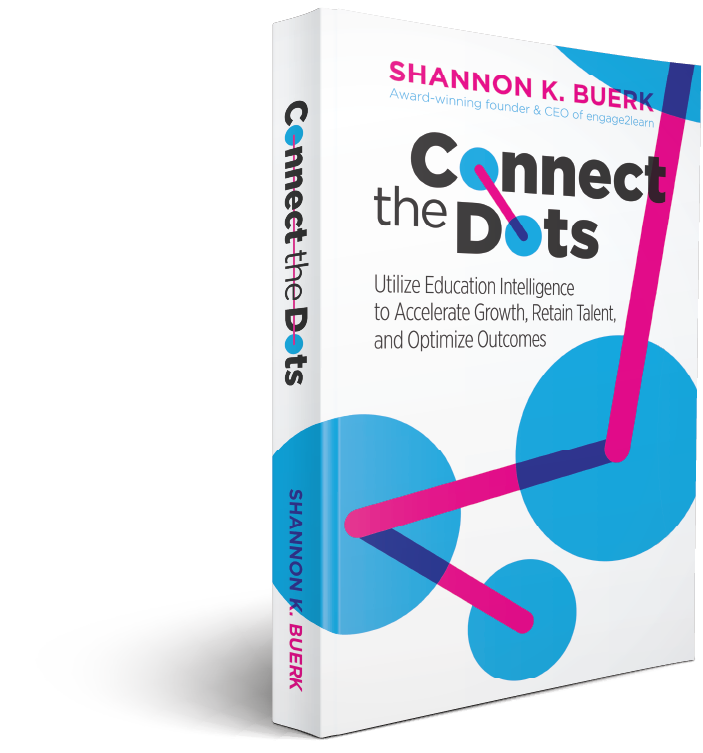
Connect the Dots:
Utilize Education Intelligence to Accelerate Growth, Retain Talent and Optimize Outcomes
This book is the definitive playbook on utilizing competency-based, adaptive professional learning to create formative professional growth analytics that can be correlated to student and employee outcomes. It is intended to be short on “why” and specific on “how.” The book describes how to measure and scale individualized talent development across an organization and how to collect and analyze critical growth data patterns to make strategic decisions. It is intended to be highly actionable, providing leaders with everything they need to implement immediately and with fidelity.
Chapter Summary:
Chapter 1: Getting Smarter
Chapter 1 lays the foundation for the book, highlighting the importance of effective educators and covering some common challenges faced in public education (i.e., the lack of effective data systems and analysis tied to educator and student growth) and typical solutions that have not yet resulted in the desired outcomes: increased educator performance and student achievement. This chapter introduces the Engage Growth Method as an individualized, competency- and evidence-based system that accelerates teacher and student growth in tandem while collecting the structured growth data to create Education Intelligence.
Resources:
- Engage Growth Method Rubric (p. 65)
Chapter 2: Competency-Based Professional Growth
Chapter 2 highlights the rising and alarming issue of teacher attrition and the subsequent need for effective professional support that reduces overwhelm and retains highly qualified educators. This chapter demonstrates the urgency to stop providing one-size-fits-all training and shift to individualized, competency-based smart professional learning. Readers are offered a deep dive into what codified competencies are; three potential options for how to develop them; and how to utilize them to create a structure for professional growth that can be repeated, measured, correlated, and scaled.
Resources:
- Sample Rubric: Assessment & Formative Feedback (pg. 89)
- Best Practices Crosswalk Template (pg. 101)
Chapter 3: Evidence-Based Coaching
Chapter 3 discusses the current observation-based coaching methods and why they should be revamped to create more educator agency in the process. This chapter details an evidence-based coaching conversation model as the most efficient and effective level in a coaching system. Readers will learn how to apply the [# of coaching conversations]:[# of classroom observations] ratio proven to have the most impact on educator and student growth. The chapter also explores the importance of evidence-based recognition systems for rewarding and accelerating growth, as well as how to use systems to efficiently manage the coaching processes.
Resources:
- Coach Profile Workspace (pg. 140)
- Sample Coaching Video (pg. 146)
- eGrowe + See It, Name It, Do It (pg. 148)
- Beliefs to Behaviors Workspace (pg. 149)
Chapter 4: Individualized Pathways
Chapter 4 explains the importance of differentiating and personalizing professional learning for teachers in the same way we do for students. This chapter explains how to deconstruct one-size-fits-all training to create a professional learning library made up of organized, asynchronous professional learning resources aligned to competencies as the basis of personalized pathways. Educators are empowered to utilize a goal-setting process and adaptive choices that ensure ownership of the learning. Finally, the chapter addresses scaling support to every employee of an educational organization to create a culture of growth. The reader learns about how to intentionally design a high-performing culture of learning in which all individuals in any role or level of the system can thrive.
Chapter 5: Connecting the Dots
Chapter 5 dives deeper into the concept of Education Intelligence (EI), including which types of data to collect and how to construct reports to inform the EI system. Examples of reports on efforts, impacts, growth, and connected visualizations will provide readers with the building blocks for constructing a powerful EI system that connects inputs to outcomes and creates information and insights out of formerly disconnected data sets. The book concludes with a peek into what the incredible future of a public education system enhanced by Education Intelligence could look like.
Resources:
- Success Criteria Workspace (pg. 227)
- Table: Enhancing Practice with Education Intelligence (pg. 251)
- Connect the Dots: Personalized Playlist (pg. 255)
- Graphic: Connect the Dots Mind Map